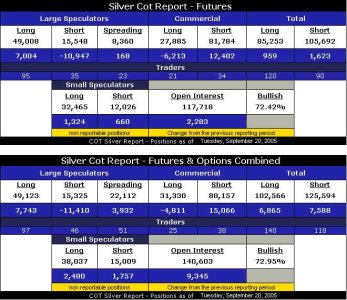WorldLove
Attenzione !!!
- Registrato
- 27/7/01
- Messaggi
- 1.624
- Punti reazioni
- 43
Cosa vi dicevo degli Hedge Fund sacrificabili (e sacrificati).... sul sacro altare dell'apparente non inflazione ?
Manipolazione tassi...
Manipolazione prezzi oro ed argento...
Qualcosa comincia a venire alla luce...
---------------------------------------------------
Scandal rocks New York brokerage firm
· Refco chief executive owed company $430m
· Accounts cannot be relied upon for accuracy
The esoteric world of derivatives was rocked by scandal yesterday when leading futures brokerage Refco, which has substantial operations in London and New York, said it had discovered that chief executive Phillip Bennett owed the company $430m (£250m) and that none of its accounts dating back to 2002 could be relied upon for their accuracy.
The disclosure is likely to increase calls for tighter controls of the high risk and often arcane financial instruments that have seen phenomenal growth over recent years in the City and on Wall Street.
Refco is one of the world's largest and most powerful commodities dealers, but its interests also spread across most financial assets, such as currencies and bonds. It specialises in derivative brokerage services. Last year it was the biggest trader on the Chicago Mercantile Exchange, the largest derivatives exchange in the United States.
In an opaque statement, Refco said that a company controlled by Mr Bennett had assumed "certain historical obligations" owed by third parties to Refco that "may have been uncollectable". He did so without telling the Refco board.
Analysts said that one interpretation could be that Mr Bennett had attempted to hide the bad debts. The firm said the amount did appear as a receivable on prior financial statements and on the balance sheet, but it as not shown as a related party transaction. The company warned that its financial statements for the past four years could no longer be relied upon. Mr Bennett, who has now repaid the money to the firm, has been put on leave pending further investigation.
Shares in Refco fell by a third yesterday as investors vented their anger. The company was floated in the US as recently as August, when the firm raised $583m. Part of that ire and possibly legal action is likely to be directed at the banks Credit Suisse First Boston, Goldman Sachs and Bank of America, which led the share sale, and the accounting firm Grant Thornton, which audited Refco's books. A year before the IPO, the private equity firm Thomas H Lee led an investor group that ploughed $507m of equity into Refco for a 57% stake.
The firm's chief operating officer, William Sexton, who had previously been planning to leave the company, said he would now remain with the firm as chief executive. "I am staying at Refco because I believe in our employees, customers and franchise," he said. Another executive, Santo Maggio, chief executive of Refco Securities and Refco Capital Markets, has taken a leave of absence.
The company tried to reassure clients and said that all of its customer funds on deposit are unaffected by the discovery. At the end of August, Refco said it had cash and cash equivalents of $649m.
Investigative lawyers and forensic accountants have been drafted in to investigate the books of the firm. Meanwhile, Refco has delayed the filing of its next quarterly financial results. A spokeswoman said the company doesn't know if a restatement will be required.
Refco has already had run-ins with American regulators this year, with the securities and exchange commission threatening action over alleged market manipulation in May. Last last month the company was the target of a law suit from a French investor, claiming that Refco had misled investors in its public filings and demanding compensation of £1.4bn.
What it is
Refco is a diversified financial services firm best known for its futures brokerage - dealing with contracts to buy or sell specific quantities of a commodity at a specified price in the future. It employs 2,400 people in 14 countries. Last year it was the biggest trader on the Chicago Mercantile Exchange.
http://www.guardian.co.uk/business/story/0,3604,1589110,00.html
Manipolazione tassi...
Manipolazione prezzi oro ed argento...
Qualcosa comincia a venire alla luce...
---------------------------------------------------
Scandal rocks New York brokerage firm
· Refco chief executive owed company $430m
· Accounts cannot be relied upon for accuracy
The esoteric world of derivatives was rocked by scandal yesterday when leading futures brokerage Refco, which has substantial operations in London and New York, said it had discovered that chief executive Phillip Bennett owed the company $430m (£250m) and that none of its accounts dating back to 2002 could be relied upon for their accuracy.
The disclosure is likely to increase calls for tighter controls of the high risk and often arcane financial instruments that have seen phenomenal growth over recent years in the City and on Wall Street.
Refco is one of the world's largest and most powerful commodities dealers, but its interests also spread across most financial assets, such as currencies and bonds. It specialises in derivative brokerage services. Last year it was the biggest trader on the Chicago Mercantile Exchange, the largest derivatives exchange in the United States.
In an opaque statement, Refco said that a company controlled by Mr Bennett had assumed "certain historical obligations" owed by third parties to Refco that "may have been uncollectable". He did so without telling the Refco board.
Analysts said that one interpretation could be that Mr Bennett had attempted to hide the bad debts. The firm said the amount did appear as a receivable on prior financial statements and on the balance sheet, but it as not shown as a related party transaction. The company warned that its financial statements for the past four years could no longer be relied upon. Mr Bennett, who has now repaid the money to the firm, has been put on leave pending further investigation.
Shares in Refco fell by a third yesterday as investors vented their anger. The company was floated in the US as recently as August, when the firm raised $583m. Part of that ire and possibly legal action is likely to be directed at the banks Credit Suisse First Boston, Goldman Sachs and Bank of America, which led the share sale, and the accounting firm Grant Thornton, which audited Refco's books. A year before the IPO, the private equity firm Thomas H Lee led an investor group that ploughed $507m of equity into Refco for a 57% stake.
The firm's chief operating officer, William Sexton, who had previously been planning to leave the company, said he would now remain with the firm as chief executive. "I am staying at Refco because I believe in our employees, customers and franchise," he said. Another executive, Santo Maggio, chief executive of Refco Securities and Refco Capital Markets, has taken a leave of absence.
The company tried to reassure clients and said that all of its customer funds on deposit are unaffected by the discovery. At the end of August, Refco said it had cash and cash equivalents of $649m.
Investigative lawyers and forensic accountants have been drafted in to investigate the books of the firm. Meanwhile, Refco has delayed the filing of its next quarterly financial results. A spokeswoman said the company doesn't know if a restatement will be required.
Refco has already had run-ins with American regulators this year, with the securities and exchange commission threatening action over alleged market manipulation in May. Last last month the company was the target of a law suit from a French investor, claiming that Refco had misled investors in its public filings and demanding compensation of £1.4bn.
What it is
Refco is a diversified financial services firm best known for its futures brokerage - dealing with contracts to buy or sell specific quantities of a commodity at a specified price in the future. It employs 2,400 people in 14 countries. Last year it was the biggest trader on the Chicago Mercantile Exchange.
http://www.guardian.co.uk/business/story/0,3604,1589110,00.html





 ... un protettore di Fazio
... un protettore di Fazio  ... uno con simpatie strane
... uno con simpatie strane 